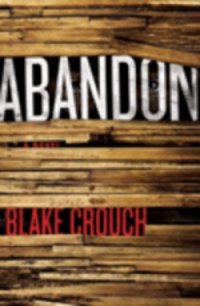Rita Hayworth and Shawshank Redemption - King Stephen Edwin (читать книги бесплатно полные версии .txt) 📗
I believe now that it began in 1949, way back then — not with the rock-hammer, but with the Rita Hayworth poster. I told you how nervous he seemed when he asked for that, nervous and filled with suppressed excitement. At the time I thought it was just embarrassment, that Andy was the sort of guy who’d never want someone else to know that he had feet of clay and wanted a woman … even if it was only a fantasy-woman. But I think now that I was wrong. I think now that Andy’s excitement came from something else altogether.
What was responsible for the hole that Warden Norton eventually found behind the poster of a girl that hadn’t even been born when that photo of Rita Hayworth was taken? Andy Dufresne’s perseverance and hard work, yeah — I don’t take any of that away from him. But there were two other elements in the equation: a lot of luck, and WPA concrete.
You don’t need me to explain the luck, I guess. The WPA concrete I checked out for myself. I invested some time and a couple of stamps and wrote first to the University of Maine History Department and then to a fellow whose address they were able to give me. This fellow had been foreman of the WPA project that built the Shawshank Max Security Wing.
The wing, which contains Cellblocks 3, 4, and 5, was built in the years 1934—37. Now, most people don’t think of cement and concrete as ‘technological developments’, the way we think of cars and oil furnaces and rocket-ships, but they really are. There was no modern cement until 1870 or so, and no modern concrete until after the turn of the century. Mixing concrete is as delicate a business as making bread. You can get it too watery or not watery enough. You can get the sand-mix too thick or too thin, and the same is true of the gravel-mix. And back in 1934, the science of mixing the stuff was a lot less sophisticated than it is today.
The walls of Cellblock 5 were solid enough, but they weren’t exactly dry and toasty. As a matter of fact, they were and are pretty damned dank. After a long wet spell they would sweat and sometimes even drip. Cracks had a way of appearing, some an inch deep, and were routinely mortared over.
Now here comes Andy Dufresne into Cellblock 5. He’s a man who graduated from the University of Maine’s school of business, but he’s also a man who took two or three geology courses along the way. Geology had, in fact, become his chief hobby. I imagine it appealed to his patient, meticulous nature. A ten-thousand-year ice age here. A million years of mountain-building there. Tectonic plates grinding against each other deep under the earth’s skin over the millennia. Pressure. Andy told me once that all of geology is the study of pressure.
And time, of course.
He had time to study those walls. Plenty of time. When the cell door slams and the lights go out, there’s nothing else to look at.
First-timers usually had a hard time adjusting to the confinement of prison life. They get screw-fever, they have to be hauled down to the infirmary and sedated couple of times before they get on the beam. It’s not unusual to hear some new member of our happy little family bang on the bars of his cell and screaming to be let out … before the cries have gone on for long, the chant starts up along the cellblock: ‘Fresh fish, hey little fishie, fresh fish, fresh fish, got fresh fish today!’
Andy didn’t flip out like that when he came to the Shank 1948, but that’s not to say that he didn’t feel many of same things. He may have come close to madness; some and some go sailing right over the edge. Old life blown away in the wink of an eye, indeterminate nightmare stretching out ahead, a long season in hell.
So what did he do, I ask you? He searched almost desperately for something to divert his restless mind. Oh, there are all sorts of ways to divert yourself, even in prison; it seems like the human mind is full of an infinite number of possibilities when it comes to diversion. I told you about the sculptor and his Three Ages of Jesus. There were coin collectors who were always losing their collections to thieves, stamp collectors, one fellow who had postcards from thirty-five different countries — and let me tell you, he would have turned out your lights if he’d caught you diddling with his postcards.
Andy got interested in rocks. And the walls of his cell.
I think that his initial intention might have been to do no more than to carve his initials into the wall where the poster of Rita Hayworth would soon be hanging. His initials, or maybe a few lines from some poem. Instead, what he found was that interestingly weak concrete. Maybe he started to carve his initials and a big chunk of the wall fell out I can see him, lying there on his bunk, looking at that broken chunk of concrete, turning it over in his hands. Never mind the wreck of your whole life, never mind that you got railroaded into this place by a whole trainload of bad luck. Let’s forget all that and look at this piece of concrete.
Some months further along he might have decided it would be fun to see how much of that wall he could take out. But you can’t just start digging into your wall and then, when the weekly inspection (or one of the surprise inspections that are always turning up interesting caches of booze, drugs, dirty pictures, and weapons) comes around, say to the guard: This? Just excavating a little hole in my cell wall. Not to worry, my good man.’
No, he couldn’t have that. So he came to me and asked if I could get him a Rita Hayworth poster. Not a little one but a big one.
And, of course, he had the rock-hammer. I remember thinking when I got him that gadget back in ’48 that it would take a man six hundred years to burrow through the wall with it. True enough. But Andy went right through the wall — even with the soft concrete, it took him two rock-hammers and twenty-seven years to hack a hole big enough to get his slim body through four feet of it. Of course he lost most of one of those years to Normaden, and he could only work at night, preferably late at night, when almost everybody is asleep — including the guards who work the night shift. But I suspect the thing which slowed him down the most was getting rid of the wall as he took it out. He could muffle the sound of his work by wrapping the head of his hammer in rock-polishing cloths, but what to do with the pulverized concrete and the occasional chunks that came out whole?
I think he must have broken up the chunks into pebbles and…
I remembered the Sunday after I had gotten him the rock-hammer. I remember watching him walk across the exercise yard, his face puffy from his latest go-round with the sisters. I saw him stoop, pick up a pebble … and it disappeared up his sleeve. That inside sleeve-pocket is an old prison trick. Up your sleeve or just inside the cuff of your pants. And I have another memory, very strong but unfocused, maybe something I saw more than once. This memory is of Andy Dufresne walking across the exercise yard on a hot summer day when the air was utterly still. Still, yeah … except for the little breeze that seemed to be blowing sand around Andy Dufresne’s feet.
So maybe he had a couple of cheaters in his pants below the knees. You loaded the cheaters up with fill and then just strolled around, your hands in your pockets, and when you feel safe and unobserved, you gave the pockets a little twitch. The pockets, of course, are attached by string or strong thread to the cheaters. The fill goes cascading out of your pantslegs as you walk. The World War II POWS who were trying to tunnel out used the dodge.
The years went past and Andy brought his wall out to the exercise yard cupful by cupful. He played the game with administrator after administrator, and they thought it was because he wanted to keep the library growing. I have no doubt that was part of it, but the main thing Andy wanted was to keep cell 14 in Cellblock 5 a single occupancy.




